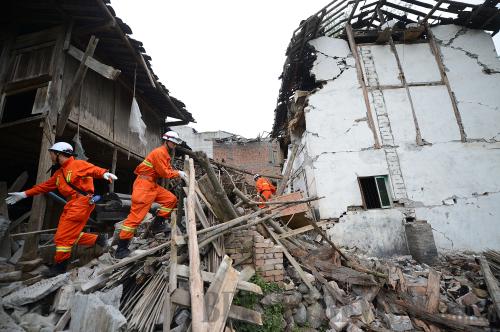|
 |
|
SEARCH AND RESCUE: Rescue workers search through rubble for survivors in Lushan County, Ya'an City in Sichuan Province, on April 21 (WANG XIAO) |
Arelaxing Saturday morning in a rural area of tranquil Sichuan Province suddenly turned disastrous when an earthquake struck the southwest Chinese province where the economic, social and environmental impacts of the devastating 2008 Wenchuan earthquake still linger.
At 8:02 a.m. local time on April 20, the initial 7.0-magnitude shockwave jarred Ya'an City, a vista renowned for giant pandas, with a population of 1.53 million. Tremors were palpable as far away as Chengdu, 150 km from Ya'an proper and 170 km from Lushan County, the epicenter.
Inhabitants were scurrying from apartment buildings in pajamas when a 5.1-magnitude aftershock hit the bordering area between Lushan and Baoxing counties five minutes after the first tremor. Ten more aftershocks followed within the next two hours.
The China Earthquake Networks Center (CENC) had recorded 4,551 aftershocks by 8 a.m. on April 25. Authorities reported 196 dead, 21 missing and 11,470 injured on April 24. The quake directly affected over 2.31 million people in Sichuan.
News of the earthquake spread quickly online. The first report emerged 53 seconds after the first tremor, when the Chengdu Institute of Carelife microblogged, "Earthquake strikes Sichuan again." Many netizens reblogged the report.
Hi-tech help
More than 2,000 soldiers from the Chengdu Military Area Command (MAC) rushed to the area for rescue and relief work. The Chengdu MAC also set up a rescue and relief headquarters and a medical relief team covering the quake-hit region.
One hour after the quake, two helicopters of the Chengdu MAC took off from Jiajiang County to survey the developments on the ground.
Air support has played a vital role in rescue efforts. Three hours after the quake, a cargo plane took off to ship a national rescue team to the quake-hit area while four emergency helicopter squads rushed to the worst-hit areas to locate trapped people and set up temporary helipads.
In the first 72 hours after the quake, the PLA (People's Liberation Army) Air Force shipped about 900 people out and more than 120 tons of relief materials into the quake zone.
With roads to remote townships intermittently blocked by rockslides, the air force started the first airdrop operation on April 22, delivering food and water to thousands of survivors left homeless.
"The efficiency of rescue and relief work is closely linked to the capacity of air support," said Cai Suwei, a senior air force officer in command of the rescue work. "We need to further improve the fast response capacity of the air force to minimize casualties in natural disasters."
The latest development of military technologies, including a satellite navigation system and unmanned aerial vehicle (UAV), were employed in the rescue work.
Many important deployments have been made based on latest pictures of the quake-hit areas taken by satellites, drones and reconnaissance aircraft.
"From these high-resolution aerial photos, we can locate landslides and determine which roads are blocked and which parts are damaged most," said Zhou Xiaozhou, head of the Quake Rescue and Relief Headquarters of the Chengdu MAC. "The rescue and relief teams have responded quickly mainly because the country has established an aerial intelligence network covering a large area and collecting precise information in an efficient way."
| 